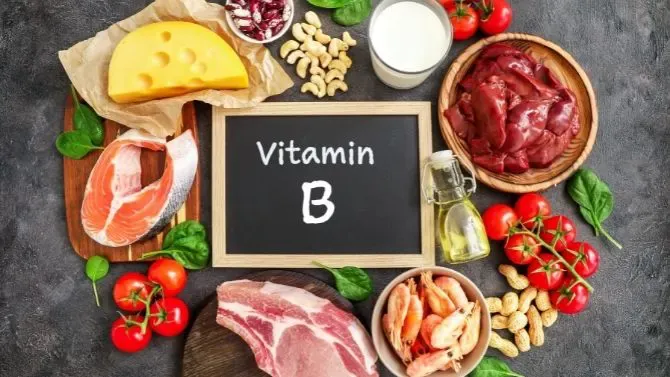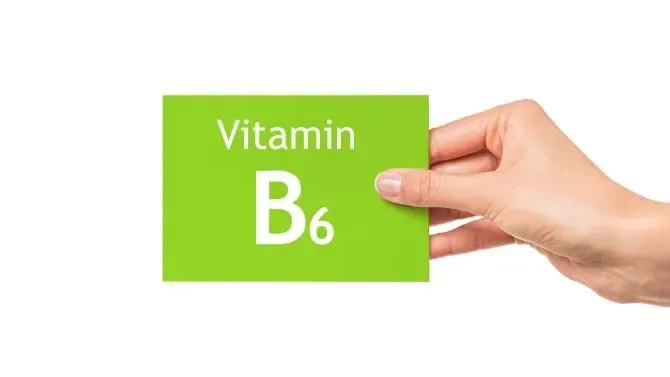Vitamin B6

What does vitamin B6 do?

What is vitamin B6?
Discovered in 1935, vitamin B6 was synthesized in a laboratory in 1939. Its various functions were found by scientists in the years that followed.Although it is not synthesized by the body, vitamin B6, also called pyridoxine, is an essential element for the functioning of the human body. This water-soluble vitamin, which belongs to the B group, is broken down into six active forms.
Pyridoxine, pyridoxamine, pyridoxine 5-phosphate, pyridoxamine 5-phosphate, pyridoxal, and pyridoxal-5-phosphate or PLP. In this final form, the compounds of vitamin B6 are transformed after digestion and assimilation.
To be assimilated correctly, vitamin B6 needs all the other vitamins of the group in insufficient and adequate quantities.
The body cannot build up stores of vitamin B6 in any form, and its contribution is, therefore, essentially food. Fruits and vegetables provide vitamin B6 in the form of pyridoxine, while animal products offer the following states: pyridoxamine 5-phosphate and pyridoxal 5-phosphate.
This information is essential to adapt food intake and ensure sufficient nutrient intake.
Role and benefits of vitamin B6
Vitamin B6 performs several essential functions in the body. The roles of vitamin B6 are:- Participates in the assimilation of vitamin B12, magnesium, and the synthesis of hydrochloric acid.
- Intervenes in the metabolism of amino acids and, therefore, in the production of proteins.
- Constitutes a precursor element for synthesizing hemoglobin, red blood cells, immune cells (antibodies), and neurotransmitters (serotonin, dopamine, norepinephrine). Vitamin B6 contributes to the balance of the immune system and the maintenance of the psychic and nervous balance of the individual.
- Ensures the transformation of tryptophan into vitamin B3.
- Also involved in the production of energy needed by the body, from carbohydrate compounds stored in the muscles (glycogen).
- Reduction of premenstrual symptoms (irritability, anxiety, abdominal pain, and bloating).
- Reduction of nausea and vomiting, especially during the first trimester of pregnancy.
- Prevent cardiovascular diseases (in combination with taking vitamin B9 and B12).
There are dietary supplements fortified with vitamin B6 available for purchase. However, it is best to consult a doctor before taking any medication or vitamin B6 supplementation.
Symptoms of vitamin B6 deficiency
Vitamin B6 deficiencies impact the metabolism of amino acids and proteins, as well as on the various functions mentioned above.Vitamin B6 deficiencies are generally observed in malnourished people or suffer from kidney failure.
Alcoholism, hyperthyroidism, and rheumatoid arthritis can also cause vitamin B6 under dosage. The characteristic symptoms of deficiencies are:
- Megaloblastic anemia: this pathology affects stem cells, precursors of red blood cells
- Irritability
- Confused state
- In alcoholics: glossitis, an inflammation of the tongue
- Tired
- Muscle loss
- Depression
- Alteration of skin cells
- Peripheral neuropathy: This pathology causes pain in the extremities (hands, feet, etc.), difficulty walking
B6 Recommended nutritional allowances
The recommended daily allowances of vitamin B6 are easily provided by food. As with every nutrient, they vary depending on their age, period of growth, and gender.

Vitamin B6 is present in most foods, making it easy to absorb as part of a balanced diet.
Many particular breakfast portions of cereal, marketed in supermarkets, are enriched with vitamin B6. However, they are very high in sugars, so consume in moderation. Here are our five favorite foods containing vitamin B6.
To be eaten at least twice a week, these fish are deliciously grilled, steamed, or en papillote. They are the basis of balanced menus accompanied by vegetables or starches, and a simple squeeze of lemon can enhance the taste of your fish dishes without added fat.
With content reaching 0.7 to 1.2 mg per 100 g, adding this food to your menu ensures the recommended daily requirement of vitamin B6, depending on your age.
To be cooked grilled, in a pan or in the oven, for a tasty and light dish. If you are pregnant, it is best to avoid consuming organ meats.
Consuming chicken or turkey breasts grilled in the oven, without skin, is the basis of a diet and low-fat diet. Think about it to prepare light dishes while benefiting from the tasty taste of these meats.
You can eat them with a variety of vegetables, to which you will add an essential portion of starchy foods to avoid cravings in the afternoon or at night.
The potato is the basis of delicious dishes, such as mashed potatoes, mashed potatoes, gratins, or soups. How you consume is up to you. Added to a meal, a portion of mashed or mashed potatoes is a good starch source.
However, they are still very high in calories. It is, therefore, better to consume them in small quantities to benefit from their benefits in vitamin B6. An alternative is to add it to dishes and salads!
A final reminder: vitamin B6 is a water-soluble vitamin. To limit the loss of this element during cooking, prefer steaming, en papillote, or in the oven.
 In high doses, vitamin B6 is neurotoxic; that is to say, it alters the cells of the brain, particularly those of the nervous system. The undesirable effects observed in this case are:
In high doses, vitamin B6 is neurotoxic; that is to say, it alters the cells of the brain, particularly those of the nervous system. The undesirable effects observed in this case are:
To limit vitamin B6 overdoses, it is preferable not to consume food supplements enriched with pyridoxine. In case of suspicion of deficiency, the reflex to adopt is to consult a doctor to avoid the appearance of possible complications.
Symptoms of overdoses usually disappear a few months after stopping supplementation.
- Babies from 0 to 1 year: 0.3 mg/day
- Child aged 1 to 3 years: 0.5 to 0.6 mg/day
- Child aged 4 to 8 years: 0.6 to 0.8 mg/day
- Child aged 9 to 13 years: 1 to 1.3 mg/day
- Teenager 13 to 15 years old: 1.2 to 1.5 mg/day
- From 16 years old: 1.5 to 1.8 mg/day
- Pregnant or breastfeeding women: 2 mg/day
- Seniors (> 75 years old): 2.2 mg/day
Top 5 Foods Containing Vitamin B6

Many particular breakfast portions of cereal, marketed in supermarkets, are enriched with vitamin B6. However, they are very high in sugars, so consume in moderation. Here are our five favorite foods containing vitamin B6.
1. Oily fish
Rich in good fatty acids, fatty fish such as mackerel, salmon, or tuna contain vitamin B6. The vitamin content is 0.5-0.7 mg per 100 g of fish.To be eaten at least twice a week, these fish are deliciously grilled, steamed, or en papillote. They are the basis of balanced menus accompanied by vegetables or starches, and a simple squeeze of lemon can enhance the taste of your fish dishes without added fat.
2. Offal
Rich in iron and vitamin B9, organ meats, such as calf, lamb, chicken, or heifer liver, contain vitamin B6.With content reaching 0.7 to 1.2 mg per 100 g, adding this food to your menu ensures the recommended daily requirement of vitamin B6, depending on your age.
To be cooked grilled, in a pan or in the oven, for a tasty and light dish. If you are pregnant, it is best to avoid consuming organ meats.
3. Poultry
Turkey and chicken are low-calorie meats belonging to the poultry category. They are rich in vitamin B6 (about 0.6 g per 100 g of turkey or chicken cutlet).Consuming chicken or turkey breasts grilled in the oven, without skin, is the basis of a diet and low-fat diet. Think about it to prepare light dishes while benefiting from the tasty taste of these meats.
You can eat them with a variety of vegetables, to which you will add an essential portion of starchy foods to avoid cravings in the afternoon or at night.
4. Potatoes
Baked potatoes contain 0.3 mg of pyridoxine per 100 g. Excellent news, there are a thousand ways to cook them!The potato is the basis of delicious dishes, such as mashed potatoes, mashed potatoes, gratins, or soups. How you consume is up to you. Added to a meal, a portion of mashed or mashed potatoes is a good starch source.
5. Pistachios
Pistachios are usually eaten roasted as an appetizer. In this form, they provide an intake of approximately 1.4 g per 100 g.However, they are still very high in calories. It is, therefore, better to consume them in small quantities to benefit from their benefits in vitamin B6. An alternative is to add it to dishes and salads!
Good to know: wheat germ and brewer's yeast are supplements rich in vitamin B6. Content: 1.4 mg per 100 g for the first and 2.6 mg per 100 g for the second.
Dangers, side effects, and overdoses of vitamin B6

- Memory problems
- Neurological disturbances, even neuropathy
To limit vitamin B6 overdoses, it is preferable not to consume food supplements enriched with pyridoxine. In case of suspicion of deficiency, the reflex to adopt is to consult a doctor to avoid the appearance of possible complications.
Symptoms of overdoses usually disappear a few months after stopping supplementation.
Read More\
Post a Comment